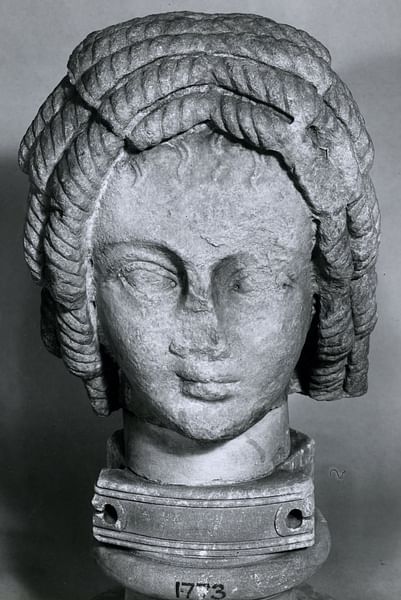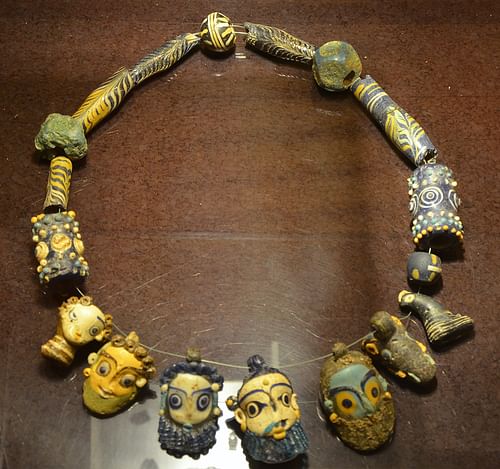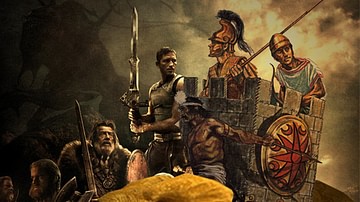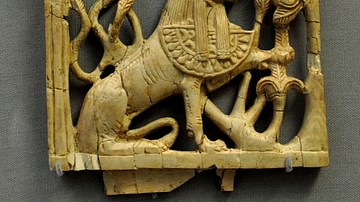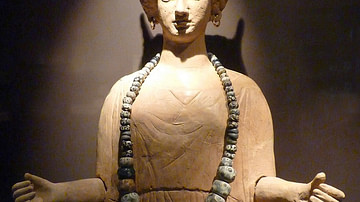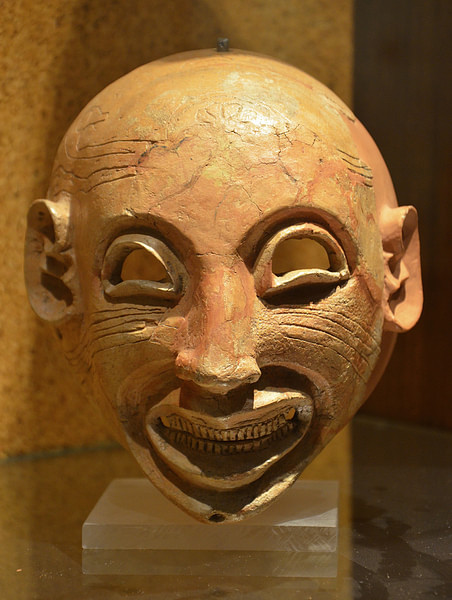
The art of the Carthaginians was an eclectic mix of influences and styles, which included Egyptian motifs, Greek fashion, Phoenician gods, and Etruscan patterns. Precious metals, ivory, glass, terracotta, and stone were transformed into highly decorative objects ranging from everyday utensils to purely ornamental pieces. Just as the Carthaginians imported and exported all manner of trade goods, so too their art reflected their vast network of contacts across the ancient Mediterranean but they would eventually produce their own distinctive art which uniquely blended elements from other cultures. The distinctive qualities of Punic art can be best seen in their stelae, jewellery, sculpture, and masks.
Surviving examples of Carthaginian art are sadly few in comparison to contemporary cultures, and they are further limited in scope by the fact that the majority of artefacts come from a burial context and so are predominantly small in scale and of a religious nature. Secular art and objects produced exclusively for their aesthetic value are rare indeed. Nevertheless, enough examples survive of jewellery, figurines, ceramics, and stonework to hint that the Carthaginians were not as artistically impoverished as earlier historians saw fit to claim.
Influences
Carthage was founded in the 9th century BCE by colonists from the Phoenician city of Tyre. This fact and the city's continued close ties with the mother country meant that art was heavily influenced by that of Phoenicia, at least in its formative years. Just as Phoenicia was itself a melting pot of diverse cultures, its wealth based as it was on maritime trade, so too Carthage would become a cosmopolitan city with visitors, residents, and artists from across the ancient Mediterranean. Egyptian art was particularly influential and many motifs are seen in Carthaginian art such as the goat with head looking backwards beneath a sacred tree or rigid standing female figures. Near Eastern art was another strong influence, seen especially in figurines of the god Melqart/Baal. The influence of Etruscan artists is seen especially in Carthaginian pottery decoration from the 4th century BCE.
Above all, though, Carthage's art took inspiration from the Greek world from the 5th century BCE onwards. Not only were the Carthaginians appreciative collectors of Greek art, taking fine art as booty from their campaigns in Sicily, but they also produced imitative art. There was a large Greek community at Carthage, and many of these must have worked as skilled craftsmen in the workshops of the city. In turn, they would have taught local artists or the next generation. We know of at least one artist whose father was a Greek immigrant but who signed his work as 'Boethus the Carthaginian' and who became so appreciated that his work was dedicated at Olympia.
There is a general problem of identifying the exact origin of many art pieces which is exacerbated by the Punic habit of copying foreign motifs and styles. Traditionally, historians had favoured the view that, at least in general, finer pieces were imported and more rustic art was locally made. This unflattering view is steadily being revised following the discovery of large workshop areas in the city suggesting a healthy export trade and by new archaeological discoveries so that the position that all of the fine art was imported is becoming increasingly untenable.
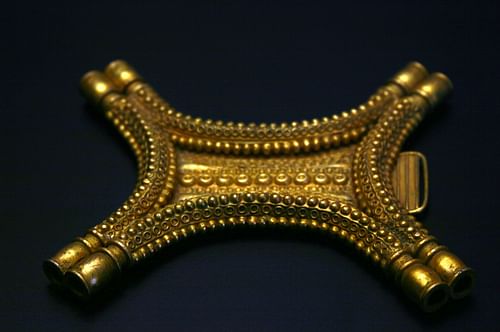
Materials
The materials used by Carthaginian artists were many. Coloured glass and glass paste were used to make jewellery beads and small perfume amphorae. Ivory was carved to make decorative plaques which could be hung on walls or added to furniture. Sometimes semi-precious stones, glass or faience were added to these plaques for extra sparkle. The same material was carved to make such everyday items as knife and mirror handles, combs, small boxes, and intaglios. Terracotta was used to make figurines of deities, masks, incense burners, and simple cups, bowls, and trefoil-jugs. It was also used to make circular decorative plaques. Gold was employed for jewellery and could be hammered, cast, granulated, repoussé, or applied as gold leaf. Surviving gold pendants take the form of fruit, small busts, and objects from nature such as a chrysalis. Stone, in rare cases also marble, was carved to produce tomb stelae, ossuaries, and small temples placed above graves. Bronze was employed for figurines, and especially common were hatchet razors. Left with the deceased in tombs for use in the after-life, they often have a swan or ibis-headed handle and were beautifully incised with images of gods from the Phoenician, Greek, or Egyptian pantheon.
Common Media & Themes
Figurines & Masks
Figurines of a female goddess, probably considered a protectress, are a relatively common dedication in early tombs and graves. They were also offered either as a request for or in thanks for healing. The figures are simply rendered with a flat-topped head and cylinder body. Figurines of the god Melqart sitting on a throne, with his right hand raised in blessing, and typical conical hat were produced in large numbers, too.
From the 4th century BCE many figurines display a Greek influence, especially in their clothing such as the chiton and peplos robes, and himation cloak. Although the Carthaginians applied many conventions of Greek art to their own figure sculpture, it is striking that one element they did not adopt was the nude. Punic figures are always clothed. Female figures playing tambourines have been excavated at various Carthaginian sites, and some of these figures blend Greek clothing with Egyptian winged-portrayals of Isis wearing a typical Egyptian, wide collar. As with Greek sculpture, these human figures were originally brightly painted.
Cavalry riders appear in several mediums, notably on a 6th century BCE terracotta circular plaque from Douimes. The warrior wears a crested helmet, carries a circular shield, and has his dog running alongside his horse. Another terracotta product was receptacles in the shapes of animals, ducks, and cow's heads.
Grinning masks, made from painted, incised, and stamped terracotta, were given lively grimacing expressions and deep wrinkle lines. With empty eyes and open mouths, they were left in tombs in order to ward off evil spirits or hung on walls of houses for the same purpose. They were certainly not worn as they are less than life-size. These masks were produced in large numbers but are all unique. A second type was masks of smiling female faces (protomai), but these were not grotesque like the male versions. Both types could be made using moulds.
Jewellery
Necklaces composed of individual glass beads shaped into male heads are a typical item of Carthaginian jewellery. Each face has curly hair, a beard, and the large staring eyes so often seen in the faces of Punic art. Beads were also made from gold, silver, and pearls. Pendants, earrings, bracelets, nose-rings, ankle-rings, and diadems were all worn by the Carthaginians who could afford them. As with Egyptian jewellery, lions, falcons, gods, lotus blossoms, and palmettes were typical forms of decoration. Many vitreous paste beads carry eye motifs. Carthaginians, also like the Egyptians, carried tiny papyrus scrolls on their person which had written on them spells and formulas against all manner of potential disasters. These scrolls were kept in precious metal boxes incised with the motifs just mentioned.
Amulets of glass paste covered by enamel and carved seals of gold and semi-precious stones (e.g. agate and jasper) often depicted Egyptian deities such as Bes, Ptah, and Isis, or took the form of familiar Egyptian symbols like the ujat eye, crown of Upper Egypt, and lotus flower. Scarabs were produced in large numbers at Carthage too and were carved from jasper, cornelian, lapis lazuli, agate, rock crystal, basalt, and glass paste. They were worn as protection against all kinds of mishaps, as symbols of social rank and citizenship, or as a means to increase the healthiness of particular parts of the body. Intaglios are another area of Greek influence. These incised ivory jewellery pieces often depict scenes from Greek mythology, especially involving Dionysos and Demeter.
Decorative Objects
One of the most common Punic decorative objects and a popular export was ostrich eggs. These usually have their tops cut off, but some are complete and were drained through a single small hole in the base. They were decorated with geometric forms, palms, and lotus blossoms using red paint. Symbolising regeneration or the cosmic egg of creation they were a common votive offering in tombs. Another use was to paint fragments of the shells with faces to create miniature masks.
Glass was used to produce small two-handled vessels used for storing perfumes. These had been long-produced in Phoenicia and Egypt, but the Carthaginian type is distinctive for its very dark blue glass decorated with yellow, white, or turquoise stripes achieved by adding thin trails of hot glass over the inner main shell.
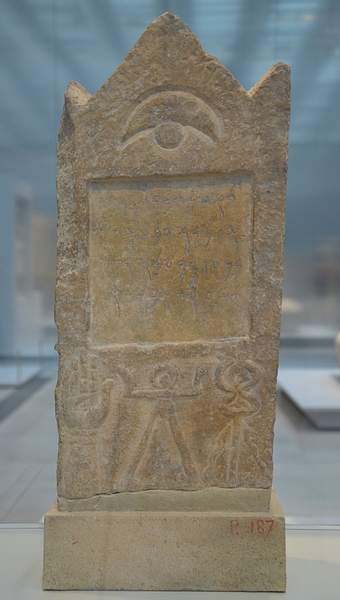
Stelae
Sandstone and limestone stelae measuring up to 1.5 metres in height are the most common medium of Punic art which survive. They were carved for placement above tombs, especially in the tophet, where many carry a lozenge-shape, hexagon, or bottle-shaped decoration, or the symbol of Tanit. The earliest type (7th-6th century BCE) was a miniature architectural model of a temple or altar shaped like a throne. These are known as cippi (sing. cippus) and they often copied the facades of Egyptian temples and were topped by a solar disk and/or a crescent moon. Later types (from the 5th century BCE) have a triangular top and took inspiration from Greek architecture with Ionic columns and winged sphinxes used as common decorative features. An outstanding example of the eclectic mix of Carthaginian art is the stele set above the tomb of Hadrumetum, c. 250 BCE in the tophet of Carthage, with its single Ionic column topped by a sphinx above which are Egyptian-like palm fronds.
From the 3rd century BCE, portraiture was sometimes attempted and many stelae have animal figures, a hand motif, and a male figure seated on one bent leg. The exact significance of these and the earlier geometric motifs is still debated amongst historians. Many stelae show traces of stucco and paint and their production was in no way interrupted by the Roman destruction of Carthage in the mid-2nd century BCE.
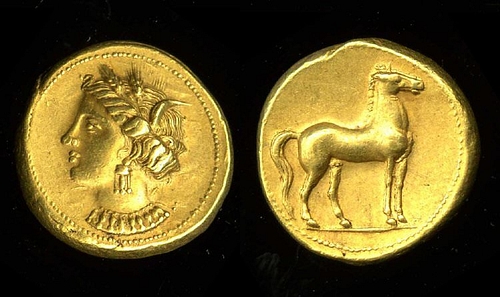
Sarcophagi
Sometimes, instead of a stele, tombs had a carved stone ossuary to preserve the bones of the deceased. Of Near East origin, these could present a full-length representation of the deceased on the lid and reproduce a life-like portrait of the face. One such example is the 4th-3rd century BCE ossuary of a priest from the Santa Monica cemetery at Borj-el-Jedid. Full-size Punic sarcophagi generally mixed Egyptian forms with a Hellenistic portraiture of the occupant on the lid. The earliest are the most Egyptian, and the person is represented in a flat view, and then, as Carthage saw more Greek influence in art in general, the figures become more three-dimensional.
Punic coins were minted in Sicily from the 5th century BCE and at Carthage itself from the 4th century BCE. The most common designs include a horse's head, a full horse with Nike above, a single palm tree, Melqart with a club like Hercules, a war elephant, the prow of a warship, a lion in front of a palm tree, and head of a female goddess (especially Tanit, less often Demeter and Kore) which were all stamped on both sides of coins of silver, gold, electrum, and bronze.
